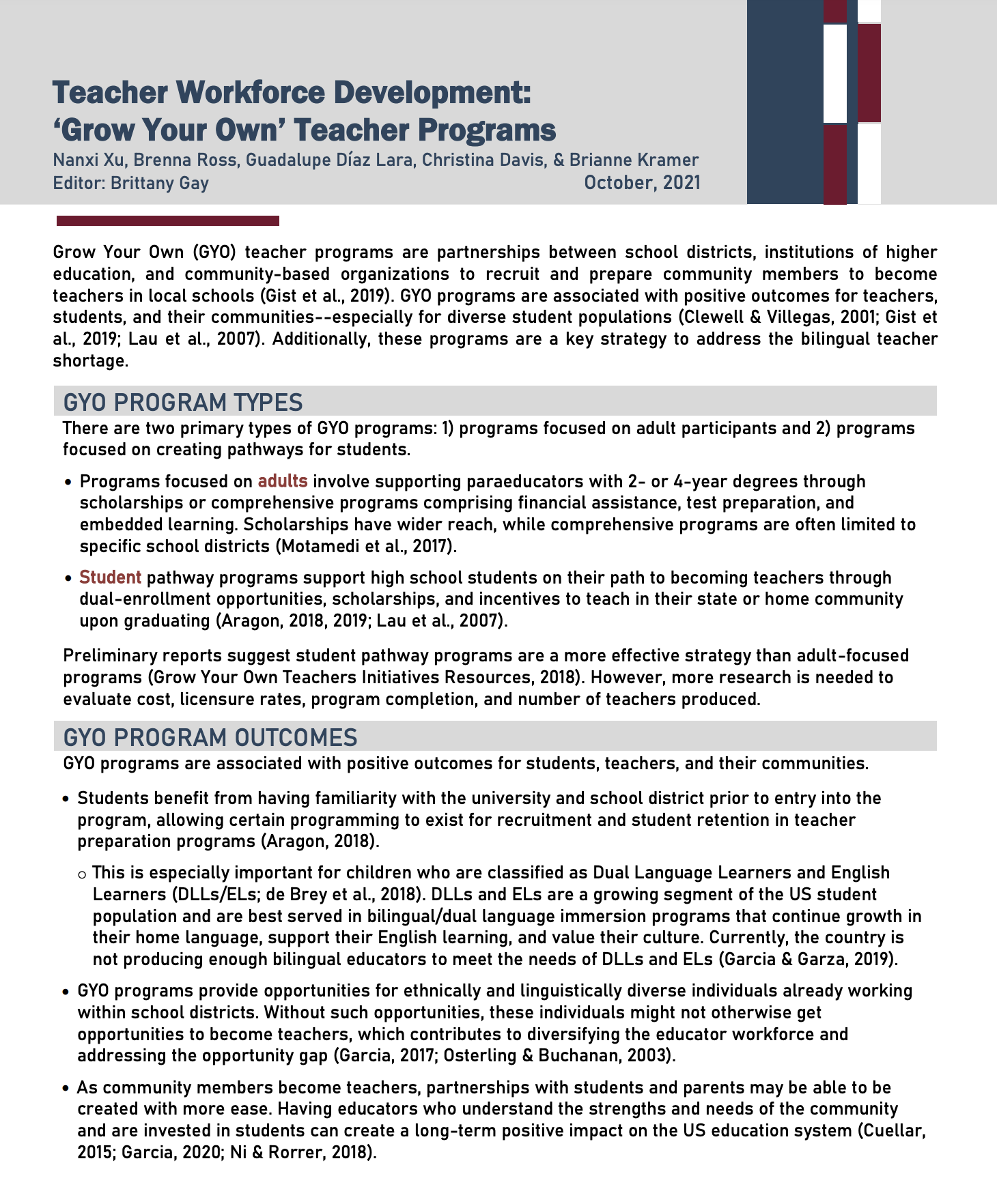
Grow Your Own (GYO) teacher programs are partnerships between school districts, institutions of higher education, and community-based organizations to recruit and prepare community members to become teachers in local schools (Gist et al., 2019). GYO programs are associated with positive outcomes for teachers, students, and their communities–especially for diverse student populations (Clewell & Villegas, 2001; Gist et al., 2019; Lau et al., 2007). Additionally, these programs are a key strategy to address the bilingual teacher shortage.
GYO Program Types
There are two primary types of GYO programs: 1) programs focused on adult participants and 2) programs focused on creating pathways for students.
- Programs focused on adults involve supporting paraeducators with 2- or 4-year degrees through scholarships or comprehensive programs comprising financial assistance, test preparation, and embedded learning. Scholarships have wider reach, while comprehensive programs are often limited to specific school districts (Motamedi et al., 2017).
- Student pathway programs support high school students on their path to becoming teachers through dual-enrollment opportunities, scholarships, and incentives to teach in their state or home community upon graduating (Aragon, 2018, 2019; Lau et al., 2007).
Preliminary reports suggest student pathway programs are a more effective strategy than adult-focused programs (Grow Your Own Teachers Initiatives Resources, 2018). However, more research is needed to evaluate cost, licensure rates, program completion, and number of teachers produced.
GYO Program Outcomes
GYO programs are associated with positive outcomes for students, teachers, and their communities.
- Students benefit from having familiarity with the university and school district prior to entry into the program, allowing certain programming to exist for recruitment and student retention in teacher preparation programs (Aragon, 2018).
- This is especially important for children who are classified as Dual Language Learners and English Learners (DLLs/ELs; de Brey et al., 2018). DLLs and ELs are a growing segment of the US student population and are best served in bilingual/dual language immersion programs that continue growth in their home language, support their English learning, and value their culture. Currently, the country is not producing enough bilingual educators to meet the needs of DLLs and ELs (Garcia & Garza, 2019).
- GYO programs provide opportunities for ethnically and linguistically diverse individuals already working within school districts. Without such opportunities, these individuals might not otherwise get opportunities to become teachers, which contributes to diversifying the educator workforce and addressing the opportunity gap (Garcia, 2017; Osterling & Buchanan, 2003).
- As community members become teachers, partnerships with students and parents may be able to be created with more ease. Having educators who understand the strengths and needs of the community and are invested in students can create a long-term positive impact on the US education system (Cuellar, 2015; Garcia, 2020; Ni & Rorrer, 2018).
Considerations
Schools need well-trained and critically conscious teachers who are committed to educating diverse students. GYO programs might offer a path for addressing this need, as well as increasing the racial and linguistic diversity of the educator workforce. As with any program, the impact of GYO programs on outcomes depends on many factors that should be considered.
- The highly localized nature of GYO programs likely contributes to their effectiveness, but this also means there is substantial variation across program design, reliance on partnerships, and the funding and training quality offered to GYO participants.
- A total of 27 states have a GYO focused policy (i.e., a statute, bill, or executive order), but funding for GYO programs is inconsistent. 18 of these states currently fund some type of GYO program (Garcia, 2021). Of those, 7 states currently fund a competitive grant program designed to incentivize school district and educator preparation partnerships to develop and implement GYO programs.
- The number of programs funded at the district level outnumbers those that are funded by state investments.
- More research is needed to examine the outcomes of different types of GYO programs, including their cost and return on investment, as well as their long-term impacts on teacher mentorship and retention.
End Notes / References
- Aragon, S. (2018). Policy snapshot: Targeted teacher recruitment. Education Commission of the States. Retrieved from: https://www.ecs.org/wp-content/uploads/Targeted_Teacher_Recruitment.pdf
- Aragon, S. (2019). Response to information request. Education Commission of the States. Retrieved from: https://www.ecs.org/wp-content/uploads/State-Info-Request-Grow-Your-Own-Programs.pdf
- Clewell, B. C., & Villegas, A. M. (2001). Ahead of the class: A handbook for preparing new teachers from new sources. Washington, DC: The Urban Institute.
- Cuellar, R. (2015). What do pre-service teachers think about the recruitment and retention of quality elementary school teachers of culturally and linguistically diverse learners? NAAAS Conference Proceedings; Scarborough C115-C127.
- de Brey, C., Musu, L., & McFarland, J. (2018). Status and trends in the education of racial and ethnic groups. U.S. Department of Education, National Center for Education Statistics. Retrieved from: https://nces.ed.gov/programs/raceindicators/
- Garcia, A. (2017). Building a bilingual teacher pipeline: Bilingual teacher fellows at highline public schools. Retrieved from: https://www.newamerica.org/education-policy/policy-papers/building-bilingual-teacher-pipeline/
- Garcia, A. (2020). Cultivating Nebraska’s indigenous roots to grow American Indian teachers. Ed Central, New America. Retrieved from: https://www.newamerica.org/education-policy/edcentral/indigenous-roots/
- Garcia, A. (2021). Grow Your Own teachers: A 50-state scan of policies and programs. New America. Retrieved from: https://www.newamerica.org/education-policy/reports/grow-your-own-teachers/
- Garcia, A., & Garza, R. (2019). Chicago’s bilingual teacher residency: A partnership to strengthen the teacher pipeline. Retrieved from: https://www.newamerica.org/education-policy/reports/chicagos-bilingual-teacher-residency-a-partnership-to-strengthen-the-teacher-pipeline/
- Gist, C., Bianco, M., & Lynn, M. (2019). Examining Grow Your Own programs across the teacher development continuum: Mining research on teachers of color and nontraditional educator pipelines. Journal of Teacher Education, 70(1), 13-25. https://journals.sagepub.com/doi/full/10.1177/0022487118787504
- Grow Your Own Teachers Initiatives Resources (2018). Texas Comprehensive Center at American Institutes for Research. Retrieved from: https://files.eric.ed.gov/fulltext/ED594981.pdf
- Lau, K. F., Dandy, E. B., & Hoffman, L. (2007). The pathways program: A model for increasing the number of teachers of color. Teacher Education Quarterly, 34(3), 27-40. https://www.jstor.org/stable/23479109
- Motamedi, J. G., Leong, M., & Yoon, S. Y. (2017). Strategies for designing, implementing, and evaluating Grow-Your-Own teacher programs for educators. Education Northwest. Retrieved from: https://ies.ed.gov/ncee/edlabs/regions/northwest/pdf/strategies-for-educators.pdf
- Ni, Y., & Rorrer, A. K. (2018). Why do teachers choose teaching and remain teaching: Initial results from the Educator Career and Pathway Survey (ECAPS) for teachers. Utah Education Policy Center: Salt Lake City, UT. Retrieved from: https://uepc.utah.edu/our-work/why-do-teachers-choose-teaching-and-remain-teaching-initial-results-from-the-educator-career-and-pathway-survey-ecaps-for-teachers/
- Osterling, J. P., & Buchanan, K. (2003). Tapping a valuable source for prospective ESOL teachers: Northern Virginia’s bilingual paraeducator career-ladder school-university partnership. Bilingual Research Journal, 27(3), 503-521.
The Research-to-Policy Collaboration (RPC) works to bring together research professionals and public officials to support evidence-based policy. Please visit their website to learn more.
Key Information
RPC Website
Research-to-Policy Collaboration
More RPC Resources
RPC Resources
Publication DateOctober 24, 2021
Topic Area(s)Education and Child Development
Resource TypeWritten Briefs
Share This Page
Grow Your Own (GYO) teacher programs are partnerships between school districts, institutions of higher education, and community-based organizations to recruit and prepare community members to become teachers in local schools (Gist et al., 2019). GYO programs are associated with positive outcomes for teachers, students, and their communities–especially for diverse student populations (Clewell & Villegas, 2001; Gist et al., 2019; Lau et al., 2007). Additionally, these programs are a key strategy to address the bilingual teacher shortage.
GYO Program Types
There are two primary types of GYO programs: 1) programs focused on adult participants and 2) programs focused on creating pathways for students.
- Programs focused on adults involve supporting paraeducators with 2- or 4-year degrees through scholarships or comprehensive programs comprising financial assistance, test preparation, and embedded learning. Scholarships have wider reach, while comprehensive programs are often limited to specific school districts (Motamedi et al., 2017).
- Student pathway programs support high school students on their path to becoming teachers through dual-enrollment opportunities, scholarships, and incentives to teach in their state or home community upon graduating (Aragon, 2018, 2019; Lau et al., 2007).
Preliminary reports suggest student pathway programs are a more effective strategy than adult-focused programs (Grow Your Own Teachers Initiatives Resources, 2018). However, more research is needed to evaluate cost, licensure rates, program completion, and number of teachers produced.
GYO Program Outcomes
GYO programs are associated with positive outcomes for students, teachers, and their communities.
- Students benefit from having familiarity with the university and school district prior to entry into the program, allowing certain programming to exist for recruitment and student retention in teacher preparation programs (Aragon, 2018).
- This is especially important for children who are classified as Dual Language Learners and English Learners (DLLs/ELs; de Brey et al., 2018). DLLs and ELs are a growing segment of the US student population and are best served in bilingual/dual language immersion programs that continue growth in their home language, support their English learning, and value their culture. Currently, the country is not producing enough bilingual educators to meet the needs of DLLs and ELs (Garcia & Garza, 2019).
- GYO programs provide opportunities for ethnically and linguistically diverse individuals already working within school districts. Without such opportunities, these individuals might not otherwise get opportunities to become teachers, which contributes to diversifying the educator workforce and addressing the opportunity gap (Garcia, 2017; Osterling & Buchanan, 2003).
- As community members become teachers, partnerships with students and parents may be able to be created with more ease. Having educators who understand the strengths and needs of the community and are invested in students can create a long-term positive impact on the US education system (Cuellar, 2015; Garcia, 2020; Ni & Rorrer, 2018).
Considerations
Schools need well-trained and critically conscious teachers who are committed to educating diverse students. GYO programs might offer a path for addressing this need, as well as increasing the racial and linguistic diversity of the educator workforce. As with any program, the impact of GYO programs on outcomes depends on many factors that should be considered.
- The highly localized nature of GYO programs likely contributes to their effectiveness, but this also means there is substantial variation across program design, reliance on partnerships, and the funding and training quality offered to GYO participants.
- A total of 27 states have a GYO focused policy (i.e., a statute, bill, or executive order), but funding for GYO programs is inconsistent. 18 of these states currently fund some type of GYO program (Garcia, 2021). Of those, 7 states currently fund a competitive grant program designed to incentivize school district and educator preparation partnerships to develop and implement GYO programs.
- The number of programs funded at the district level outnumbers those that are funded by state investments.
- More research is needed to examine the outcomes of different types of GYO programs, including their cost and return on investment, as well as their long-term impacts on teacher mentorship and retention.
End Notes / References
- Aragon, S. (2018). Policy snapshot: Targeted teacher recruitment. Education Commission of the States. Retrieved from: https://www.ecs.org/wp-content/uploads/Targeted_Teacher_Recruitment.pdf
- Aragon, S. (2019). Response to information request. Education Commission of the States. Retrieved from: https://www.ecs.org/wp-content/uploads/State-Info-Request-Grow-Your-Own-Programs.pdf
- Clewell, B. C., & Villegas, A. M. (2001). Ahead of the class: A handbook for preparing new teachers from new sources. Washington, DC: The Urban Institute.
- Cuellar, R. (2015). What do pre-service teachers think about the recruitment and retention of quality elementary school teachers of culturally and linguistically diverse learners? NAAAS Conference Proceedings; Scarborough C115-C127.
- de Brey, C., Musu, L., & McFarland, J. (2018). Status and trends in the education of racial and ethnic groups. U.S. Department of Education, National Center for Education Statistics. Retrieved from: https://nces.ed.gov/programs/raceindicators/
- Garcia, A. (2017). Building a bilingual teacher pipeline: Bilingual teacher fellows at highline public schools. Retrieved from: https://www.newamerica.org/education-policy/policy-papers/building-bilingual-teacher-pipeline/
- Garcia, A. (2020). Cultivating Nebraska’s indigenous roots to grow American Indian teachers. Ed Central, New America. Retrieved from: https://www.newamerica.org/education-policy/edcentral/indigenous-roots/
- Garcia, A. (2021). Grow Your Own teachers: A 50-state scan of policies and programs. New America. Retrieved from: https://www.newamerica.org/education-policy/reports/grow-your-own-teachers/
- Garcia, A., & Garza, R. (2019). Chicago’s bilingual teacher residency: A partnership to strengthen the teacher pipeline. Retrieved from: https://www.newamerica.org/education-policy/reports/chicagos-bilingual-teacher-residency-a-partnership-to-strengthen-the-teacher-pipeline/
- Gist, C., Bianco, M., & Lynn, M. (2019). Examining Grow Your Own programs across the teacher development continuum: Mining research on teachers of color and nontraditional educator pipelines. Journal of Teacher Education, 70(1), 13-25. https://journals.sagepub.com/doi/full/10.1177/0022487118787504
- Grow Your Own Teachers Initiatives Resources (2018). Texas Comprehensive Center at American Institutes for Research. Retrieved from: https://files.eric.ed.gov/fulltext/ED594981.pdf
- Lau, K. F., Dandy, E. B., & Hoffman, L. (2007). The pathways program: A model for increasing the number of teachers of color. Teacher Education Quarterly, 34(3), 27-40. https://www.jstor.org/stable/23479109
- Motamedi, J. G., Leong, M., & Yoon, S. Y. (2017). Strategies for designing, implementing, and evaluating Grow-Your-Own teacher programs for educators. Education Northwest. Retrieved from: https://ies.ed.gov/ncee/edlabs/regions/northwest/pdf/strategies-for-educators.pdf
- Ni, Y., & Rorrer, A. K. (2018). Why do teachers choose teaching and remain teaching: Initial results from the Educator Career and Pathway Survey (ECAPS) for teachers. Utah Education Policy Center: Salt Lake City, UT. Retrieved from: https://uepc.utah.edu/our-work/why-do-teachers-choose-teaching-and-remain-teaching-initial-results-from-the-educator-career-and-pathway-survey-ecaps-for-teachers/
- Osterling, J. P., & Buchanan, K. (2003). Tapping a valuable source for prospective ESOL teachers: Northern Virginia’s bilingual paraeducator career-ladder school-university partnership. Bilingual Research Journal, 27(3), 503-521.
The Research-to-Policy Collaboration (RPC) works to bring together research professionals and public officials to support evidence-based policy. Please visit their website to learn more.

Key Information
RPC Website
Research-to-Policy Collaboration
More RPC Resources
RPC Resources
Publication DateOctober 24, 2021
Topic Area(s)Education and Child Development
Resource TypeWritten Briefs
Share This Page
LET’S STAY IN TOUCH
Join the Evidence-to-Impact Mailing List
Keep up to date with the latest resources, events, and news from the EIC.




